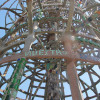Deemed outsider art, folk art, and other similarly nondescript and fluid labels, the Watts Towers do not necessarily fit the bill for a standard definition or understanding of art. But no matter what they are called, the Towers remain a cultural jewel of Los Angeles. And within the cracks and structure of these Towers lies an unfolding story and scientific mystery of sorts.
In 1921, Sabato Simon Rodia started with his home — he mosaicked the façade of his house, and some of the nearby walls. He used glass 7-Up bottles, sea glass, shells, broken plates, toys, tiles, rocks, and whatever else he could get his hands on.
And then he continued. By 1955 he had built seventeen structures, with three of those towers being most notable (the tallest at 99.5 feet high). Beginning with steel structural bases, Rodia enveloped these structural cage-like elements with concrete cement and imbued them with decorative knick-knacks and found treasures — all while free-climbing up and down the towers unprotected, without scaffolding or a harness. And with this, the Watts Towers were built.



